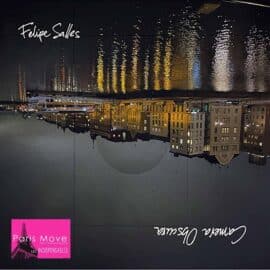| Jazz |

When Music Becomes Poetry: The Luminous Mystery of Camera Obscura
In an age when images flood our screens with relentless clarity, when stories unfold in 4K resolution at the touch of a fingertip, Felipe Salles offers a different kind of vision, one composed not of pixels but of shadows, nuance, and sonic light. His latest album, Camera Obscura, is not merely a recording but a meditation, an act of musical conjuring that transforms the very idea of perception into a suite of lyrical and cinematic compositions. Here, music becomes poetry, and for the wandering soul, Camera Obscura becomes a quiet, haunting refuge.
From the very first notes, where the saxophone, full of breath and intention, either weaves or sketches a narrative (depending on how you choose to listen), Felipe Salles introduces a work rooted in both grace and identity. It is a voice shaped by geography, by memory, and by a deep engagement with the history of sound. The piano, arriving with delicate authority, expands the emotional landscape, and together they invite us into a world where echoes linger, and each pause is part of the story.
Before the era of streaming epics and palm-sized screens, there was the camera obscura, Latin for “dark chamber”, a simple device that used a pinhole to project the world outside onto a surface within. A natural phenomenon more than a technological marvel, it offered the earliest glimpses of visual representation, not as reproduction but as interpretation. Light and shadow, not pixels and polish. It is this metaphor that drives the conceptual architecture of Salles’s album.
“A camera obscura doesn’t project reality exactly,” Salles notes. “It creates an image made of light, shadows, and perspective. I wondered: how can that become music?” And so, Camera Obscura unfolds as an auditory exploration of contrast, between brightness and darkness, presence and absence, density and stillness. The arrangements are not just intelligent; they are profoundly evocative, filled with cinematic touches that play like scenes etched in chiaroscuro. Despite its compositional complexity, this is music that speaks to the universal, because its imagery is so visceral.
In essence, Salles offers his own film, one of poetry and enigma, of joy and longing, of questions left hanging in the silence. The album pairs his long-standing quartet, featuring pianist Nando Michelin, bassist Keala Kaumeheiwa, and drummer Steve Langone (a frequent collaborator but a first-time recording member here)—with the Cushman String Quartet. Violinists Laura Arpiainen and Amanda Stenroos, violist Anton Boutkov, and cellist Karl Knapp bring a lush, tactile depth to the music. Brazilian vocalist Tatiana Parra adds her voice on À Deriva (Adrift), a piece built around a text by Salles’s sister, the poet and writer Helena Tabatchnik.
And through it all, Salles himself becomes a one-man wind section, layering soprano and tenor saxophones, piccolo, concert flute, alto and bass flutes, clarinet, and bass clarinet. The effect is often orchestral, yet intimate, like the slow turn of a reel in a forgotten projector.
The pacing of Camera Obscura is breath-like, natural, almost tidal in its undulations. “It took me thirty years to find my own approach,” Salles reflects. “Now I have the maturity to write this music with my voice, with my vision.” That vision is deeply shaped by his journey, from his birthplace in São Paulo, Brazil, to the jazz corridors of the United States, where he has been a vital force since 1995. Along the way, he has collaborated with luminaries such as Randy Brecker, Paquito D’Rivera, David Liebman, Melissa Aldana, Lionel Loueke, Jerry Bergonzi, Magos Herrera, Sofia Rei, Yosvany Terry, and Luciana Souza, among others.
The result is an album of undeniable aesthetic sophistication. Its classical influences—never heavy-handed, add texture and architecture, serving as scaffolding for Salles’s luminous storytelling. Camera Obscura does not dazzle with spectacle. It seduces with shadows, with carefully chosen silences, with the slow unfurling of a vision that refuses to conform to immediacy.
In a world saturated with speed and surface, Felipe Salles reminds us that depth takes time, and that sometimes, the clearest truths appear not in the light, but in the half-light, where imagination and memory meet.
Thierry De Clemensat
Member at Jazz Journalists Association
USA correspondent for Paris-Move and ABS magazine
Editor in chief – Bayou Blue Radio, Bayou Blue News
PARIS-MOVE, June 1st 2025
Follow PARIS-MOVE on X
::::::::::::::::::::::::
Musicians :
Felipe Salles saxophones, with pianist Nando Michelin, bassist Keala Kaumeheiwa, and drummer Steve Langone, and with The Cushman Quartet, featuring violinists Laura Arpiainen and Amanda Stenroos, violist Anton Boutkov and cellist Karl Knapp.
Track Listing:
Camera Obscura
Remembrance (For David Liebman)
Perspective
Memory (for my mother)
Rooms
A Deriva (Adrift)
Perception
Platus
Lucidity
Trem De Prata

